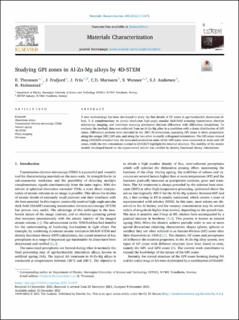| dc.contributor.author | Thronsen, Elisabeth | |
| dc.contributor.author | Frafjord, Jonas | |
| dc.contributor.author | Friis, Jesper | |
| dc.contributor.author | Marioara, Calin Daniel | |
| dc.contributor.author | Wenner, Sigurd | |
| dc.contributor.author | Andersen, Sigmund Jarle | |
| dc.contributor.author | Holmestad, Randi | |
| dc.date.accessioned | 2022-08-10T08:46:20Z | |
| dc.date.available | 2022-08-10T08:46:20Z | |
| dc.date.created | 2022-01-08T16:18:17Z | |
| dc.date.issued | 2021 | |
| dc.identifier.citation | Materials Characterization, 185, 10. | en_US |
| dc.identifier.issn | 1044-5803 | |
| dc.identifier.uri | https://hdl.handle.net/11250/3011029 | |
| dc.description.abstract | A new methodology has been developed to study the fine details of GP zones in age-hardenable aluminium alloys. It is complementary to atomic resolution high-angle annular dark-field scanning transmission electron microscopy imaging, and combines scanning precession electron diffraction with diffraction simulations. To evaluate the method, data was collected from an Al-Zn-Mg alloy in a condition with a dense distribution of GPI zones. Diffraction patterns were recorded in the 〈001Al orientation, capturing GPI zones in three projections: along the unique [001]GPI axis, and along the two other mutually orthogonal orientations. The GPI zones viewed along [001]GPI revealed how the truncated octahedron units of the GPI zones were connected in multi-unit GP zones, while the two orientations normal to [001]GPI highlight the internal structure. The stability of the atomic models developed based on the experimental results was verified by density functional theory calculations. | en_US |
| dc.language.iso | eng | en_US |
| dc.publisher | Elsevier | en_US |
| dc.relation.uri | https://doi.org/10.1016/j.matchar.2021.111675 | |
| dc.rights | Navngivelse 4.0 Internasjonal | * |
| dc.rights.uri | http://creativecommons.org/licenses/by/4.0/deed.no | * |
| dc.subject | Aluminium | en_US |
| dc.subject | Aluminium | en_US |
| dc.subject | Elektrondiffraksjon | en_US |
| dc.subject | Electron diffraction | en_US |
| dc.subject | Transmisjonselektronmikroskopi | en_US |
| dc.subject | Transmission electron microscopy | en_US |
| dc.title | Studying GPI zones in Al-Zn-Mg alloys by 4D-STEM | en_US |
| dc.type | Peer reviewed | en_US |
| dc.type | Journal article | en_US |
| dc.description.version | publishedVersion | en_US |
| dc.rights.holder | © 2021 The Authors. Published by Elsevier Inc. | en_US |
| dc.subject.nsi | VDP::Metallurgi: 521 | en_US |
| dc.subject.nsi | VDP::Metallurgy: 521 | en_US |
| dc.source.pagenumber | 10 | en_US |
| dc.source.volume | 185 | en_US |
| dc.source.journal | Materials Characterization | en_US |
| dc.identifier.doi | 10.1016/j.matchar.2021.111675 | |
| dc.identifier.cristin | 1976949 | |
| dc.relation.project | Norges teknisk-naturvitenskapelige universitet: DIGITAL TRANSFORMATION | en_US |
| dc.relation.project | Norges forskningsråd: 294933 | en_US |
| dc.relation.project | Norges forskningsråd: 197405 | en_US |
| dc.relation.project | Notur/NorStore: NN8068K | en_US |
| dc.relation.project | Notur/NorStore: NN9158K | en_US |
| dc.source.articlenumber | 111675 | en_US |
| cristin.ispublished | true | |
| cristin.fulltext | original | |
| cristin.qualitycode | 1 | |

